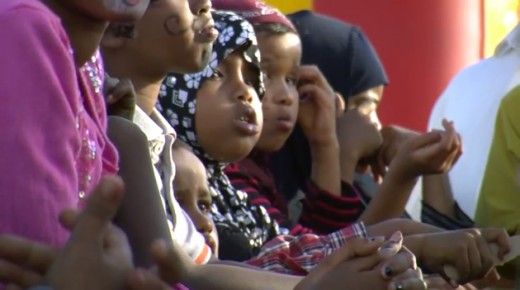
The children of East African refugees in City Heights watch their mothers present on the need for better medical interpretation. Often, medical providers and patients call on English-speaking children to interpret at doctors appointments. | Photo Credit: Megan Burks
By Megan Burks
One of the problems with getting medical interpretation over the phone is that people sometimes assume all East Africans speak the same language.
When I reported on lax medical interpretation in City Heights last month, refugees told me they could wait hours to get an interpreter on the phone, only to find out the hospital requested an interpreter for the wrong language. While City Heights is home to the second-largest Somali community in the United States, it is also home to Amharic-speaking Ethiopians, Tigre-speaking Eritreans and Swahili- and Arabic-speaking people from throughout East Africa. Add to that multiple dialects within the languages, and the chances of getting the wrong person on the phone multiply.
It turns out getting proper medical interpretation is also tricky on California’s central coast, where Mexican farmworkers don’t necessarily speak Spanish.
After a University of Southern California health blog featured our story, HealthyCal.org‘s Kate Moser took up the issue. She found farmworkers from Ventura County to the Bay Area speak 23 indigenous languages from 13 Mexican states. It isn’t enough for providers to ask “which language the patient speaks, but which township in the Mexican state of Oaxaca, for example, that person comes from.”
Just as language barriers can have serious implications in San Diego — I shared the story of a woman who sustained permanent damage during childbirth because she couldn’t tell the doctor she was circumcised — farmworkers in central California face dire consequences.
|
In one recent case, Young said, a Mixtec child presented in a Ventura County emergency room with an apparent respiratory infection. It turned out that the child had choked on food and was suffering from a blocked airway. The child died.
“Can you say this was because they weren’t able to give an accurate history?” Young said. “Well, no, I don’t think you can say that — but I think you can ask the question: Would they have suspected a foreign body, is it possibly a language interpretation question? In my mind, yes it is.” |
Moser keys in on why poor medical interpretation is an issue throughout the state.
|
Access to interpreter services in health care facilities is a persistent problem in California, said Ellen Wu, executive director of the California Pan-Ethnic Health Network.
“Even though there are laws on the books, the consumers don’t necessarily know about them – that they have a right to ask for them,” Wu said. “No one’s monitoring whether they’re being complied with, and providers aren’t always prioritizing this.” It’s difficult to track whether the state department of health is monitoring the state Kopp Act of 1983, Wu said. Complaints about violations are filed with the local district offices, but they’re not categorized by race, ethnicity or language, she said. Isolated limited-English immigrant groups also may be hesitant to report violations, she added. |
| In the coming months, I’ll continue to shed light on health care barriers as the state works out how to best expand health coverage under the Affordable Care Act. |
Already, our story on interpretation and last week’s story with Heather Boerner on care for multi-status families were picked up by Fronteras Desk, a news service for public radio stations in the southwest. The City Heights stories were broadcast on Texas Public Radio and Southern California Public Radio.
Do you have a health care story that more people should know about? Have a question about what the Affordable Care Act means for people at the neighborhood level? Email me at meburks@kpbs.org and we’ll figure out all of this complicated medical stuff together.
